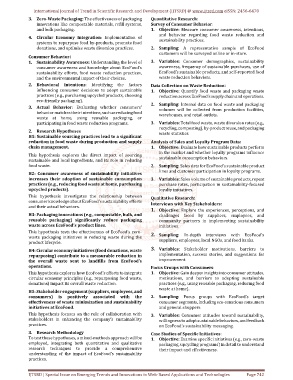Page 752 - Emerging Trends and Innovations in Web-Based Applications and Technologies
P. 752
International Journal of Trend in Scientific Research and Development (IJTSRD) @ www.ijtsrd.com eISSN: 2456-6470
3. Zero-Waste Packaging: The effectiveness of packaging Quantitative Research:
innovations like compostable materials, refill systems, Survey of Consumer Behavior:
and bulk packaging. 1. Objective: Measure consumer awareness, intentions,
and behavior regarding food waste reduction and
4. Circular Economy Integration: Implementation of
sustainability practices.
systems to repurpose food by-products, promote food
donations, and optimize waste diversion practices. 2. Sampling: A representative sample of EcoFood
Consumer Behavior: customers will be surveyed online or in-store.
1. Sustainability Awareness: Understanding the level of 3. Variables: Consumer demographics, sustainability
consumer awareness and knowledge about EcoFood’s awareness, frequency of sustainable purchases, use of
sustainability efforts, food waste reduction practices, EcoFood’s sustainable products, and self-reported food
and the environmental impact of their choices. waste reduction behaviors.
2. Behavioral Intentions: Identifying the factors Data Collection on Waste Reduction:
influencing consumer decisions to adopt sustainable 1. Objective: Quantify food waste and packaging waste
practices (e.g., purchasing upcycled products, choosing reduction across EcoFood’s supply chain and operations.
eco-friendly packaging).
2. Sampling: Internal data on food waste and packaging
3. Actual Behavior: Evaluating whether consumers’ volumes will be collected from production facilities,
behavior matches their intentions, such as reducing food warehouses, and retail outlets.
waste at home, using reusable packaging, or
participating in food waste reduction programs. 3. Variables: Total food waste, waste diversion rates (e.g.,
2. Research Hypotheses recycling, composting), by-product reuse, and packaging
waste statistics.
H1: Sustainable sourcing practices lead to a significant
reduction in food waste during production and supply Analysis of Sales and Loyalty Program Data:
chain management. 1. Objective: Evaluate how sustainable products perform
in the market and whether loyalty programs influence
This hypothesis explores the direct impact of sourcing
sustainable and local ingredients, and its role in reducing sustainable consumption behaviors.
food waste. 2. Sampling: Sales data for EcoFood’s sustainable product
lines and customer participation in loyalty programs.
H2: Consumer awareness of sustainability initiatives
increases their adoption of sustainable consumption 3. Variables: Sales volume of sustainable products, repeat
practices (e.g., reducing food waste at home, purchasing purchase rates, participation in sustainability-focused
upcycled products). loyalty initiatives.
This hypothesis investigates the relationship between Qualitative Research:
consumer knowledge about EcoFood’s sustainability efforts Interviews with Key Stakeholders:
and their actual behaviors.
1. Objective: Explore the experiences, perceptions, and
H3: Packaging innovations (e.g., compostable, bulk, and challenges faced by suppliers, employees, and
reusable packaging) significantly reduce packaging community partners in implementing sustainability
waste across EcoFood’s product lines. initiatives.
This hypothesis tests the effectiveness of EcoFood’s zero-
2. Sampling: In-depth interviews with EcoFood’s
waste packaging initiatives in reducing waste during the
suppliers, employees, local NGOs, and food banks.
product lifecycle.
H4: Circular economy initiatives (food donations, waste 3. Variables: Stakeholder motivations, barriers to
repurposing) contribute to a measurable reduction in implementation, success stories, and suggestions for
the overall waste sent to landfills from EcoFood’s improvement.
operations. Focus Groups with Consumers:
This hypothesis explores how EcoFood’s efforts to integrate 1. Objective: Gain deeper insights into consumer attitudes,
circular economy principles (e.g., repurposing food waste, motivations, and barriers to adopting sustainable
donations) impact its overall waste reduction. practices (e.g., using reusable packaging, reducing food
waste at home).
H5: Stakeholder engagement (suppliers, employees, and
consumers) is positively associated with the 2. Sampling: Focus groups with EcoFood’s target
effectiveness of waste minimization and sustainability consumer segments, including eco-conscious consumers
initiatives at EcoFood. and general shoppers.
This hypothesis focuses on the role of collaboration with 3. Variables: Consumer attitudes toward sustainability,
stakeholders in enhancing the company’s sustainability willingness to adopt sustainable behaviors, and feedback
practices. on EcoFood’s sustainability messaging.
3. Research Methodology Case Studies of Specific Initiatives:
To test these hypotheses, a mixed-methods approach will be 1. Objective: Examine specific initiatives (e.g., zero-waste
employed, integrating both quantitative and qualitative packaging, upcycling programs) in detail to understand
research techniques to provide a comprehensive their impact and effectiveness.
understanding of the impact of EcoFood’s sustainability
practices.
IJTSRD | Special Issue on Emerging Trends and Innovations in Web-Based Applications and Technologies Page 742

